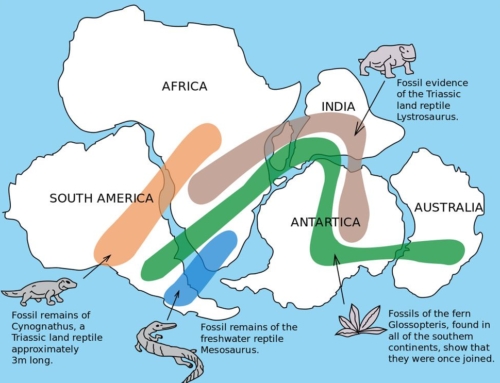In history and the historical sciences it is not possible to conduct a test on a past event. To test hypotheses certain assumptions may have to be made, for example that:
- present-day conditions applied at the time of the event;
- written or verbal records provide accurate evidence of the event;
- artefacts represent a certain type of behaviour;
- the event can be simulated by computer or other means.
For an hypothesis and its assumptions to be validated, it is necessary to assess it against as many such assumptions as possible.
A case study
Consider the mysterious explosion that occurred near the Tunguska River in remote Siberia at 7.17 am on 30 June 1908. The evidence for the fact of the explosion is overwhelming:
- an estimated 80 million trees over 830 square miles (2,150 square kilometres) were knocked over as a result;
- seismic equipment in different parts of the world recorded an event equivalent to 5.0 on the Richter scale at this time;
- fluctuations in atmospheric pressure and effects on the light of the night sky were reported as far away as England;
- a deterioration of atmospheric transparency for several months was recorded in observatories in the US;
- the testimony of those near the event, and press reports at the time.
But what caused the explosion? The evidence for this has been elusive and in consequence many hypotheses have been developed. They range from an asteroid or comet impact to the airburst of a meteor just above the earth’s surface but no impact craters or meteorite debris have been found in the area. More speculative have been a UFO crash, a small black hole passing through the earth, the annihilation of antimatter from space, a natural nuclear explosion or, for those living in the area at the time, the beginning of the end of the world.
Eye-witness accounts vary but include reference to a strong light in the sky, a hot wind, all the symptoms of an earthquake, and sounds like heavy artillery fire over a period of time. Some press reports appear unreliable and one which reported they “were unable to study the meteorite closely because it was red hot…” quite untrue.
- Uprooted trees at Tunguska
The Universities of Bologna, Italy and Tomsk, Russia have been conducting field work at the site for a number of years.1
This has included a mapping of the fallen trees from which a trajectory azimuth and inclination of the cosmic body has been calculated. Based on this tree fall data and eyewitness accounts it is suggested that there was a multiple bolide which burnt up at a height of about 6-8 km above the ground.2
A key factor in the field work has been the search for any evidence of an impacting body. This included sampling from the bed of Lake Cheko, located close to the epicentre of the inferred event. A 3-D sonar image showed that the lake’s bed was funnel-shaped, quite unlike others in the area and is considered as possibly indicative of a meteoric impact. Sesmic-reflection profiles of the bottom of Lake Cheko revealed, beneath a finely layered recent sedimentation, a chaotic level and at about 10 metres below, a strong refective surface suggesting a high-density object.
- Map of the way the trees fell.
- Lake Cheko, Siberia
- Sonar image of the bed of Lake Cheko.
- Sesmic-reflection profile of Lake Cheko
The unexpected discoveries about the bed of Lake Cheko have led to the development of a hypothesis that the lake is a water-filled impact crater. There is, however, no evidence that the lake is of 20th century origin and the degree of sedimentation supports this. The characteristic rim of an impact crater is missing.3 The hypothesis is currently being tested but little supporting evidence has been found to date; the results of recent magnetometer surveys and rock analyses have not yet been published.4 An alternative hypothesis assumes that the bright night skies observed as far away as England were the result of noctilucent clouds formed from the water vapour of a disintegrating comet.5
Other research involving supercomputers at the Sandia National Laboratories in the USA has simulated the fireball that might be expected from an asteroid exploding in the Earth’s atmosphere.This suggests that a small object would have been sufficient to cause the devastation of the Tunguska disaster.6
- Computer simulation of a fireball
Thus the evidence supports the view that the Tunguska explosion was an extra-terrestrial event. Whether it was the outcome of a meteoric impact, a disintegrating comet or an asteroid explosion in the earth’s atmosphere remains uncertain.
Collins, G S, Artemieva, N, Wünnemann, K, Bland, P A, Reimold, W U, Koeberl, C. (2008) ‘Evidence that Lake Cheko is not an impact crater’ Terra Nova 20 (2) , 165–168;
Luca, G, Bonatti, E, Longo, G (2008) ‘Lake Cheko and the Tunguska Event: impact or non-impact?’ Terra Nova 20 (2) , 169–172. 4 News Release: ‘A century later scientists still at odds on Tunguska Event explanation,’ RIA Novosti, 22 July, 2009 5 Kelley, M C et al (2009), ‘Two‐dimensional turbulence, space shuttle plume transport in the thermosphere, and a possible relation to the Great Siberian Impact Event’, Geophys. Res. Lett., 36, L14103, doi:10.1029/2009GL038362. 6 Boslough, M B E & Crawford, D (2008), ‘Low–altitude airbursts and the impact threat’ International Journal of Impact Engineering 35 (12), 1441-1448











